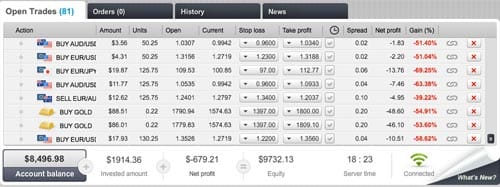While online trading has been available for independent investors since the 1990s, there have been changes aplenty in recent years. Perhaps the most significant changes have been to the way in which traders are able to access and interact with the markets.
 Traders can now monitor and analyse the markets wherever they are, using mobile devices such as tablets and smartphones. They can use, adapt, or even write their own trading algorithms to automate some or all of their trading activities. They can look at the markets in lots of different ways, using gamified trading platforms and an ever-expanding arsenal of analytical tools. They can connect with other traders on social networks, combining co-operation with competition in a way that can only accelerate the learning process. They can post their trades online as they go, and see what other trades people are making. So, you might see a lot of messages like this:
Traders can now monitor and analyse the markets wherever they are, using mobile devices such as tablets and smartphones. They can use, adapt, or even write their own trading algorithms to automate some or all of their trading activities. They can look at the markets in lots of different ways, using gamified trading platforms and an ever-expanding arsenal of analytical tools. They can connect with other traders on social networks, combining co-operation with competition in a way that can only accelerate the learning process. They can post their trades online as they go, and see what other trades people are making. So, you might see a lot of messages like this:
“Pipstrader22 closed a short EUR/USD position at 1.3234, profit 25 pips”
And, if people want to copy those trades, they can do so automatically. This is the essence of copy trading, which is essentially an offshoot of social trading. Traders can see the trades that are being made by the other traders in their network, and they can choose to mirror the activities of the most successful traders. In some cases, there will be no costs attached to doing so, but it is common for the more experienced traders to charge a fee, commission, or subscription for those who want to piggy back their trades.
Why traders share
The lure of a second significant revenue stream from people paying to copy their trades is a major incentive for successful traders to participate in copy trading networks. It provides them with additional capital to invest with, potentially magnifying their profitability.
Because the trade volumes for independent traders are very small in comparison with the amount of money flowing through the inter-bank forex market, there is no correlation between the activities of these traders and the movements of prices. Therefore, there is no disadvantage to sharing information in this context, whereas there might be among major institutional investors.
What’s in it for the investor?
 From an investor’s point of view, copy trading has several benefits. Perhaps the most obvious benefit, and the one that could spur the growth of this fledgeling industry more than any other, is that this process lowers the bar for those looking to get involved in the markets. Instead of spending months learning about price action strategies and Fibonacci retracements, investors can merely take a look at how certain traders have been performing, and cherry-pick the most successful to add to their portfolio.
From an investor’s point of view, copy trading has several benefits. Perhaps the most obvious benefit, and the one that could spur the growth of this fledgeling industry more than any other, is that this process lowers the bar for those looking to get involved in the markets. Instead of spending months learning about price action strategies and Fibonacci retracements, investors can merely take a look at how certain traders have been performing, and cherry-pick the most successful to add to their portfolio.
In many ways, copy trading is a half-way house between online trading and investing in mutual funds. Like a traditional fund investment, you are effectively giving your money to a proven trader in the expectation that they will make money for you. But unlike funds, you can see exactly what they are doing, and how they are doing it. If they prove to be less successful than you hoped, or you don’t like the type of risks they are taking, you can simply stop automatically copying their trades.
This provides complete transparency, and a degree of involvement that you don’t get when you hand your money to a fund manager. It also means that you can learn from the techniques of the most successful traders, and apply some of the lessons learned to your own trading activities. The fact that it is your own money at stake forces you to have a heightened awareness of the activities of the traders that you are copying, and this expedites the learning process.
As with mutual funds, there is always the danger that the trader you are following will have a bad run of luck and/or judgement, losing you money in the process. That’s why it’s worth diversifying your portfolio to include several traders, splitting your account into fractions in order to do so. That way, if one of them makes a loss, the profits from the other ones might be able to compensate for it.
Who to follow?
Knowing which traders to follow can be difficult, but the providers of copy trading networks have made it their mission to make it easier to sort the wheat from the chaff. On networks such as Currensee or eToro’s Openbook, traders are ranked in a league table reflecting their historic and current performance as a trader.
The criteria for ranking varies from platform to platform, with some giving more weight to the recent profitability of a trader, while others favour other factors such as risk management and discipline. The relative newness of these networks means that there aren’t any traders with particularly long track records, but as the industry matures we can expect to see more ‘blue chip’ traders emerging.
The evolution of copy trading
Copy trading first arose as an added level of functionality for social trading networks, which are themselves a relatively new phenomenon. The first social trading network to introduce this feature was eToro’s OpenBook, with the launch of their CopyTrader function.

Source: copytraders.co.uk
This was an immediate success, and before long the market was flooded with rival offerings from brokers and independent network providers. With so many firms going after a small but rapidly-expanding market, it was inevitable that some efforts would fall by the wayside. For example, OANDA’s much-trumpeted FXunity social trading platform was discontinued earlier this year, and the firm have since bought one of the broker-independent market leaders, Currensee, with a view to integrating it into their product line.
So far, most of the leading copy trading offerings have come in the form of proprietary social trading platforms, but some have taken a more integrated approach. For example, Tradeo offers a social layer for Metatrader 4 that provides the benefits of a social and copy trading network with the functionality of a powerful independent trading platform.
Copy trading has also spawned a community of its own alongside the trading networks themselves, and this is growing almost as fast as the industry itself. For example, blogs such as copytraders.co.uk provide useful insights into the differences between the various platforms, and the strategies that are required to succeed on them. Another facet of this has been the emergence of comparison tools such as those on offer at FortuneSpreads, which allow users to compare the key features and pricing of the leading social and copy trading networks.
In the next part of our guide to copy trading, we’ll be taking a look at some of the top copy trading companies, and comparing their offerings side-by-side.
Tradersdna is a leading digital and social media platform for traders and investors. Tradersdna offers premiere resources for trading and investing education, digital resources for personal finance, market analysis and free trading guides. More about TradersDNA Features: What Does It Take to Become an Aggressive Trader? | Everything You Need to Know About White Label Trading Software | Advantages of Automated Forex Trading









